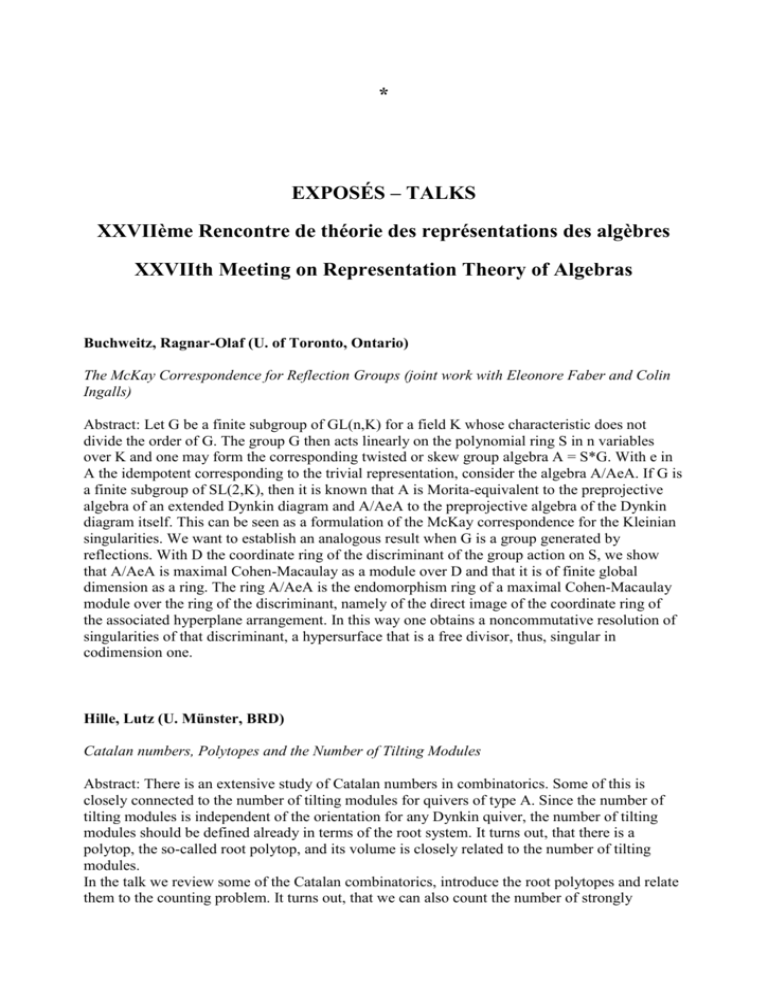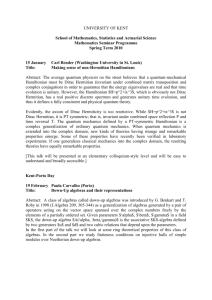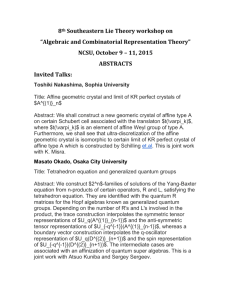finite algebra
advertisement

*
EXPOSÉS – TALKS
XXVIIème Rencontre de théorie des représentations des algèbres
XXVIIth Meeting on Representation Theory of Algebras
Buchweitz, Ragnar-Olaf (U. of Toronto, Ontario)
The McKay Correspondence for Reflection Groups (joint work with Eleonore Faber and Colin
Ingalls)
Abstract: Let G be a finite subgroup of GL(n,K) for a field K whose characteristic does not
divide the order of G. The group G then acts linearly on the polynomial ring S in n variables
over K and one may form the corresponding twisted or skew group algebra A = S*G. With e in
A the idempotent corresponding to the trivial representation, consider the algebra A/AeA. If G is
a finite subgroup of SL(2,K), then it is known that A is Morita-equivalent to the preprojective
algebra of an extended Dynkin diagram and A/AeA to the preprojective algebra of the Dynkin
diagram itself. This can be seen as a formulation of the McKay correspondence for the Kleinian
singularities. We want to establish an analogous result when G is a group generated by
reflections. With D the coordinate ring of the discriminant of the group action on S, we show
that A/AeA is maximal Cohen-Macaulay as a module over D and that it is of finite global
dimension as a ring. The ring A/AeA is the endomorphism ring of a maximal Cohen-Macaulay
module over the ring of the discriminant, namely of the direct image of the coordinate ring of
the associated hyperplane arrangement. In this way one obtains a noncommutative resolution of
singularities of that discriminant, a hypersurface that is a free divisor, thus, singular in
codimension one.
Hille, Lutz (U. Münster, BRD)
Catalan numbers, Polytopes and the Number of Tilting Modules
Abstract: There is an extensive study of Catalan numbers in combinatorics. Some of this is
closely connected to the number of tilting modules for quivers of type A. Since the number of
tilting modules is independent of the orientation for any Dynkin quiver, the number of tilting
modules should be defined already in terms of the root system. It turns out, that there is a
polytop, the so-called root polytop, and its volume is closely related to the number of tilting
modules.
In the talk we review some of the Catalan combinatorics, introduce the root polytopes and relate
them to the counting problem. It turns out, that we can also count the number of strongly
exceptional sequences with this method. At the end we give a short view to the corresponding
problem for tame and wild quivers.
Labbé, Jean-Philippe (Hebrew U. of Jerusalem, Israel)
Subword Complexes in Algebra, Discrete and Tropical Geometry.
Abstract: Subword complexes are abstract simplicial complexes defined using the theory of
Coxeter groups, first used to study the Groebner geometry of Schubert varieties. Subword
complexes turn out to enclose many important objects such as the cluster complex of finite type,
the simplicial complex of multi-triangulations, the cyclic polytope, among others. In this talk,
we will introduce subword complexes along with some known applications, before presenting
recent results in discrete and tropical geometry using subword complexes.
Lau, Michael (U. Laval, Qc)
Representations of twisted current algebras
Abstract: Current algebras are Lie algebras of regular maps from an affine variety to a finitedimensional simple Lie algebra. We will discuss some recent work on the classification of finite
dimensional and weight representations of these algebras and their twisted counterparts.
Marko, Frantisek (Penn State Hazleton, USA)
Blocks for general linear supergroup GL(m|n)
Abstract: We will discuss the linkage principle and blocks of the general linear supergroups
GL(m|n) over the ground field K of characteristic p different from 2.
Paquette, Charles (U. of Connecticut, USA)
Irreducible morphisms and locally finite dimensional representations
Abstract: Let A be a Hom-finite additive Krull-Schmidt k-category, where k is an algebraically
closed field. We consider the category mod A of additive covariant functors A --> mod k. We
provide new properties of irreducible morphisms in this setting and we prove that an almost split
sequence in mod A has to start with a finitely co-presented object and end with a finitely
presented one. As an application of these results, we give a complete description of the
Auslander-Reiten quiver of rep(Q), the category of locally finite dimensional representations of
a strongly locally finite quiver.
Plamondon, Pierre-Guy (U. de Paris-Sud, France)
Generic projective presentations
Abstract: In this talk, we will look at varieties of projective presentations, and study the
properties of the modules having these presentations
Schiffler, Ralf (U. of Connecticut, USA)
Snake graphs and continued fractions
Abstract: Snake graphs are planar graphs that were first used in the theory of cluster algebras of
surface type in order to provide combinatorial formulas for the cluster variables. These graphs
can and should be considered from a more abstract point of view as combinatorial objects, and
as such have interesting connections to several areas of mathematics. In this talk I will focus on
the relation between snake graphs and continued fractions.
Schmidmeier, Markus (Florida Atlantic U., USA)
Extensions of abelian groups with a cyclic subgroup
Abstract: For $R$ a discrete valuation ring, we consider the category $S$ of all embeddings
between finite length $R$-modules. Clearly, if $R$ is the localization of the integers at a prime
$p$, then $S$ is the category of all embeddings of a subgroup in a finite abelian $p$-group;
similarly, if $R$ is the localization of the polynomial ring at its variable, then $S$ consists of
the invariant subspaces of a nilpotent linear operator.
A {\it pole} is an indecomposable embedding $(A\subset B)$ where $A$ is an indecomposable
$R$-module; this concept has been introduced by Kaplansky in his book "Infinite abelian
groups". Littlewood-Richardson tableaux are an important isomorphism invariant for
embeddings; we study the tableaux for direct sums and extensions of poles. In particular, we
discuss how the process of exchanging two columns in the tableau gives rise to a short exact
sequence of embeddings.
We have the following application in mind. For $k$ an algebraically closed field, and for
partitions $\alpha$, $\beta$, $\gamma$, the Littlewood-Richardson tableaux of shape
$(\alpha,\beta,\gamma)$ parametrize the irreducible components of the representation space of
short exact sequences of nilpotent linear operators of Jordan types $\alpha$, $\beta$ and
$\gamma$. Manipulations of the tableaux give rise to short exact sequences, and hence provide
a handle to investigate the boundary of the irreducible components.
This project is joint work with Justyna Kosakowska from Torun.
Smith, David (U. Bishop’s, Qc)
Filtering subcategories of an artinian algebra
Abstract: Let A be an artinian algebra, and let C be a subcategory of modA that is closed under
extensions. When C is closed under kernels of epimorphisms (or closed under cokernels of
monomorphisms), we describe the smallest class of modules that filters C. As a consequence, we
obtain sufficient conditions for the finitistic dimension of an algebra over a field to be finite. We
also apply our results to the torsion pairs. In particular, when a torsion pair is induced by a tilting
module, we show that the smallest classes of modules that filter the torsion and torsion-free
classes are completely compatible with the quasi-equivalences of Brenner and Butler.
Suarez, Pamela (Universidad Nacional de Mar del Plata, Argentina)
τ-Tilting modules over one- point extensions by a projective module
Abstract By an algebra we mean a finite dimensional k-algebra over an algebraically closed
field k. Recently, Adachi, Iyama and Reiten introduced a generalization of e classical tilting
theory, which they called tau-tilting theory. It is well known that mutation of tilting modules is
not always possible. Support tau-tilting modules can be seen as a completion of the class of
tilting modules from the point of view of mutation. The authors showed that mutation of support
tau-tilting modules is always possible. In addition, tau-tilting modules satisfy nice properties of
tilting modules. In this talk, we consider an agebra A an the one-point extension of A by a
projective A-module. The aim of is work is to compare the sets of support tau-tilting modules
corresponding to such algebras. Assem, Happel and Trepode studied a similar problem in the
context of tilting modules. We prove that, if we start with a support tau-tilting module over the
smaller algebra, we can extend it to a tau-tilting module over the big one. Conversely, if we start
with a support tau-tilting module over the big algebra, we can restrict it to a support tau-tilting
module over the small one. That is, under the Restriction and the Extension fu ctors, the support
tau-tilting modules are mapped to the support tau-tilting modules. We explore e connection
between the posets of support tau-tilting modules in both algebras.
Thomas, Hugh (UQAM, Québec)
Join-irreducible elements of weak order and the representation theory of preprojective algebras
Abstract: Fix a simply-laced finite Dynkin type, with preprojective algebra $\Pi$ and Weyl
group $W$. We show that there is a bijection between a certain class of indecomposable $\Pi$modules and the join-irreducible elements of $W$ (viewed as a lattice under weak order). We
reinterpret a natural order on the join-irreducibles in terms of representation theory. This is joint
work with Osamu Iyama, Nathan Reading, and Idun Reiten.
Todorov, Gordana (Northeastern U., USA)
TBA
Treffinger, Hipolito (U. de Sherbrooke, Québec)
Tau-slices
Abstract: With the aim of completing the classical tilting theory with respect of the mutation of
tilting modules, Adachi, Iyama and Reiten introduced the $\tau$-tilting theory. Since then,
multiple works have shown that this theory behaves well as a generalization of the tilting theory
in arbitrary projective dimension. In this talk we intend to give the definition and show some of
properties of the $\tau$-slices, a slice framed in the $\tau$-tilting theory that behaves well in
different families of known algebras, such as tilted algebras or cluster-tilted algebras.
Valdivieso, Yadira (UNMDP, Argentina)
Jacobian Algebras with periodic module category and exponential growth
Abstract: The Jacobian algebra associated to a triangulation of a closed surface S with a
collection of marked points M is (weakly) symmetric and tame. We recently show that for these
algebras the Auslander-Reiten translate acts 2-periodical on objects and as consequence we have
that the Auslander-Reiten quiver of the generalized cluster category C(S,M) consists only of
stable tubes of rank 1 or 2. In this talk, we show that excluding only the case of a sphere with 4
(or less) punctures, these algebras are of exponential growth
Velez Marulanda, José (Valdosta State U., USA)
String and Band Complexes over Certain Algebra of Dihedral Type
Abstract: We give a combinatorial description of a family of indecomposable objects in the
triangulated category of perfect complexes $\mathcal{K}^b(\mathscr{P}_\A)$, where $\A$ is a
certain algebra of dihedral type (as introduced by K. Erdmann) with three simple modules. We
then discuss the shape of the corresponding components of the Auslander-Reiten quiver of
$\mathcal{K}^b(\mathscr{P}_\A)$ containing these objects.
Xu, Jinde (U. de Sherbrooke, Québec)
A new characterization of hereditary algebras
Abstract: In this talk, we give a characterization of hereditary algebras by using \tau-tilting
theory. We prove that a finite dimensional algebra A is hereditary if and only if there is no
loop in its ordinary quiver and every \tau-tilting A-module is tilting.
Yang, Yichao (U. de Sherbrooke, Québec)
Distributive lattice of tilting modules and support tau-tilting modules over path algebras
Abstract: In this paper we study the poset of basic tilting kQ-modules when Q is a Dynkin
quiver, and the poset of basic support τ-tilting kQ-modules when Q is a connected acyclic quiver
respectively. It is shown that the first poset is a distributive lattice if and only if Q is of types A1
, A2 or A3 with a nonlinear orientation and the second poset is a distributive lattice if and only if
Q is of type A1
Zhou, Ying (Brandeis U., USA)
A formula for the permutation of maximal green sequences in $A_n$ straight
orientation
Abstract: Any maximal green sequence $w$ of a valued quiver has an associated permutation.
Using picture groups, we discovered a simple formula for the permutation in $A_n$ straight
orientation and have proven this formula using semi-invariant pictures and the concepts of
standard matrices.
Zhu, Shijie (Northeastern U. USA)
Existence and Uniqueness of Minimal Right Determiner
Abstract: The concept of morphisms determined by objects was introduced by Auslander in his
distinguished Philadelphia notes where he established the general existence theorems of right
determiner. However the general existence and uniqueness of minimal right determiner has not
been noticed because in Artin algebra case they do exist and are unique obviously. We study
morphisms determined by objects in various categories and show that in a Krull-Schmidt
category, for a given morphism, the existence of the socle of the cokernel functor implies the
existence and uniqueness of the minimal right determiner. We also show that in a Krull-Schmidt
category, if the radical of endomorphism ring of every indecomposable object is nilpotent then
for any morphism either it does not have a minimal right determiner or it has a unique minimal
right determiner. More importantly, if the minimal right determiner exists then it has a close
relation with the existence of almost split sequence. We will also show that some irregularity
might happen in some categories which is not Krull-Schmidt.










